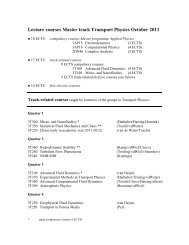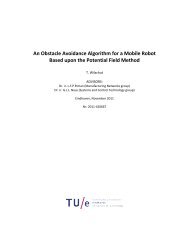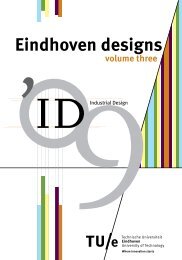Education guide 'Eindhoven designs' - Technische Universiteit ...
Education guide 'Eindhoven designs' - Technische Universiteit ...
Education guide 'Eindhoven designs' - Technische Universiteit ...
Create successful ePaper yourself
Turn your PDF publications into a flip-book with our unique Google optimized e-Paper software.
46<br />
showcase as a communication tool for a<br />
student’s overall development is a pivotal<br />
element of the assessment (see chapter<br />
eight).<br />
The showcase, often referred to as<br />
‘portfolio’, is a visual, interactive and<br />
integrative representation of students’<br />
overall development. In order to create<br />
their showcase students review what<br />
they have achieved in their learning<br />
activities of a particular semester, framed<br />
in the short-term goals they set in their<br />
PDP. They examine their deliverables,<br />
feedbacks and reflections and determine<br />
how these have contributed to and<br />
shaped their overall competence of<br />
designing and vision on designing.<br />
They evaluate this overall development,<br />
with the long-term goals in their PDP<br />
as a point of reference. This evaluation<br />
results in a coherent and overall picture<br />
of what they achieved in the semester<br />
as a whole. Students link this ‘top-layer’<br />
of the showcase to the evidence layer<br />
by including integrative reflections.<br />
The evidence layer contains a careful<br />
selection of their deliverables, feedbacks<br />
and reflections, which corroborates their<br />
overall development and growth.<br />
In order to demonstrate their growth as<br />
a designer across semesters, students<br />
include a time dimension in the toplayer<br />
of their showcase. The overall<br />
development students have achieved<br />
in a particular semester (present) is<br />
fitted in with their growth as a designer<br />
up to that point (past, which refers to<br />
previous semesters) and their view of the<br />
designer they want to become (future,<br />
which embodies the long-term goals<br />
in their PDP). The past is transformed,<br />
the present becomes the past, and the<br />
future becomes the present (see chapter<br />
eight for more detailed information on<br />
showcase).<br />
Reflection<br />
In the course of curricular learning<br />
activities, students reflect at various<br />
moments. The common element in these<br />
reflective moments is that they help<br />
students understand and enhance their<br />
learning. By reflecting they give meaning<br />
to what they are doing or, put differently,<br />
they articulate what an activity or<br />
experience means for their own learning<br />
or development. When performing a<br />
design activity, they capture valuable<br />
learning moments by reflection in action.<br />
During the (design) process they reflect<br />
on action by reviewing what they have<br />
achieved so far, or by connecting newly<br />
acquired knowledge to prior knowledge.<br />
They reflect for action by identifying<br />
what knowledge or skills they still need<br />
to acquire to accomplish high-quality<br />
deliverables, or to perform a specific task<br />
or role effectively; or by determining what<br />
design activity they need to perform as a<br />
next step. Students are advised to write<br />
these reflections on a regular basis, for<br />
example in a ‘learning journal’ (Moon,<br />
2004); and to include corresponding<br />
visualisations of their deliverables and<br />
process. At the conclusion of a curricular<br />
learning activity they reflect on and for<br />
action as well. They look back to establish<br />
what they have achieved in the learning

















